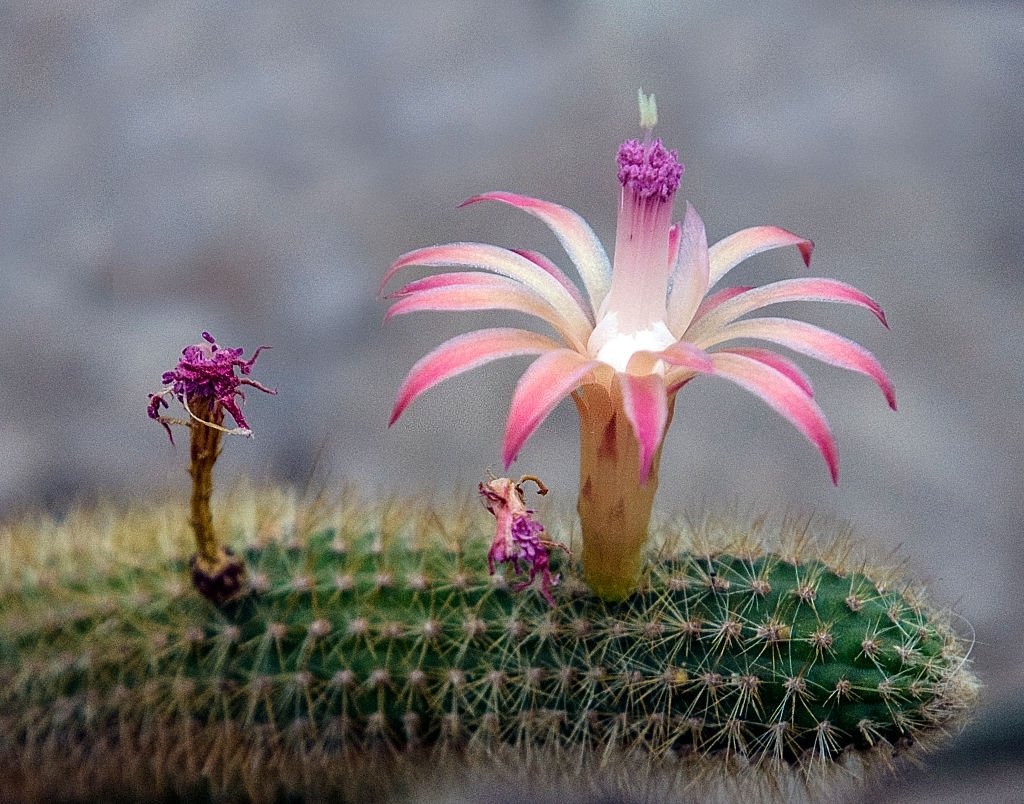Aporocactus flagelliformis commonly known as the Rat Tailed Cactus is a trailing cactus, This cacti plant is a species of flowering plant in the family of Cactus.
In addition, these plants are the most cultivated species in the genus Aporocactus. Due to its easy way of cultivation and attractive floral design, these plants often grow as ornamental potted plant which is used to beautify the surrounding.
The Cactus has an overall green appearance. The cactus has a trailing green stem with short and fine spines upon it.
The mature Rat Tailed Cactus blooms in early summers or late springs to form violet-red flowers. Sometimes the flowers formed may be orange or red as well.
Generally, the trailing cactus is grown as a houseplant in hanging pots or baskets. The stems should be cut short when they become extremely long.
According to most gardeners, caring for the Rat Tailed Cactus is quite easy. Hence, it is a suitable purchase for novice gardeners.
Identification of Rat Tail Cactus
Are you wondering that how can we identify a Rat Tailed Cactus?

There are various trailing cacti and some even look like the Rat Tail Cactus. Thus the following description may help in rightly identifying the cactus.
The Rat Tail Cactus is a trailing cactus with long and thick green stems covered with fine spines.
These Cacti species grow with a length of about 5 feet. The cactus is native to the deserts of Mexico.
For a Mini Rat Tailed Cactus, the stem is beige.
The Rat Tail Cactus blooms in late springs or early summers, with few large and tubular-shaped violet-red flowers or sometimes with pink or orange flowers. The flowers bloomed survive for only a couple of days.
Care for the Rat Tail Cactus
Are you wondering How To Care For Rat Tailed Cactus?
Well, the following points mentioned will give you a brief idea regarding How To Grow Rat Tailed Cactus with proper care. These are some of the main factors to provide the Cacti Plant for its growth and health;
Temperature
The Cactus grows well in fairly warm places with low humidity.
Growing the Rat Tail Cactus at room temperature will also lead to its proper growth.
During winters, the cactus is dormant and prefers to be kept in a cool place. But the place should not have a temperature lower than 45 degrees celsius.
An extremely hot place with a temperature above 85 degrees celsius not suitable for the healthy growth of the cacti plant.
Sunlight
The Cactus grows well in bright sunlight. Hence, it should be kept in a bright sunny place during the daytime.
If your place lacks an adequate amount of sunlight for the cactus, then you can make artificial arrangements to suit the growing conditions of the trailing cactus.
Make sure to provide adequate sunlight to the cactus or else it will grow thinner than usual and with time, the plant will turn weak.
Watering
Are you wondering How Much Water Does A Rat Tail Cactus Need? Here is your question, get its answer.
During spring and summer, which are the growing seasons for the Aporocactus flagelliformis, the cactus should be watered slightly just so the soil remains moist.
In autumn, the frequency of watering the plant reduces and is watered when the soil is quite dry.
During winter, the cactus requires watering only when the soil is bone dry.
Soil Requirements And Fertilizing
The soil mixture to be used for the healthy growth of the cactus is a rich cactus potting soil.
The cactus soil mixture can either be bought or can be prepared at home.
Now, how to prepare the cactus soil mix at home?
The cactus soil mix can be prepared at home by mixing approximately 4 parts of loam with 1 part of sand and 1 part of perlite. This soil mixture contains all the nutrients needed by the cactus for its healthy growth.
Now, how often shall we use the fertilizers upon this cactus?
The cactus is fertilized by using diluted fertilizers once every 2 weeks during the growing seasons.
Propagation of the cactus
Are you wondering how to propagate rat tail cactus?
Rattail cactus propagation is done either by seeds or by stem cutting.
Propagating rat tail cactus by seed is quite easy as we need to only plant the seeds obtained from the plant in a new pot embedded with fresh soil mix. The seeds should be kept warm and slightly moist.
The following steps will tell us how to prune the rat tail cactus and then propagate it.
Steps
- Cut a portion of the stem using sterilized scissors.
- Allow the cut-out portion to dry for a few days.
- Make sure the wounded part of the cutting forms a callus before we further continue with the process.
- Place the rat tail cactus cuttings in a new large-sized pot embedded with a fresh potting mixture.
- Make sure that the cut-out portion is kept warm and slightly moist in the potting soil mix. It should also receive an adequate amount of sunlight.
- In a few weeks, baby roots will start to form.
Potting and re-potting
Are you wondering how to plant a rat tail cactus?
The planting of the rattail cactus can be done by planting its seed in a new hanging pot embedded with the suited soil mix. Or, we can plant a baby rat tail cactus in the pot thereby cutting short the caring period for the cactus.
Now, How To Replant Rat Tail Cactus cactus?
The growth rate of the Aporocactus Flagelliformis is pretty high. As a result, it requires being re-potted at least once a year during the growing seasons.
The re-potting is done in fairly large hanging pots embedded with fresh soil mix.
Re-potting of the Rattail Cactus helps to replenish the nutrients used up by it.
Blossoming of the cactus
The ideal blooming period for the Rat Tail Cactus is during late springs and early summers.
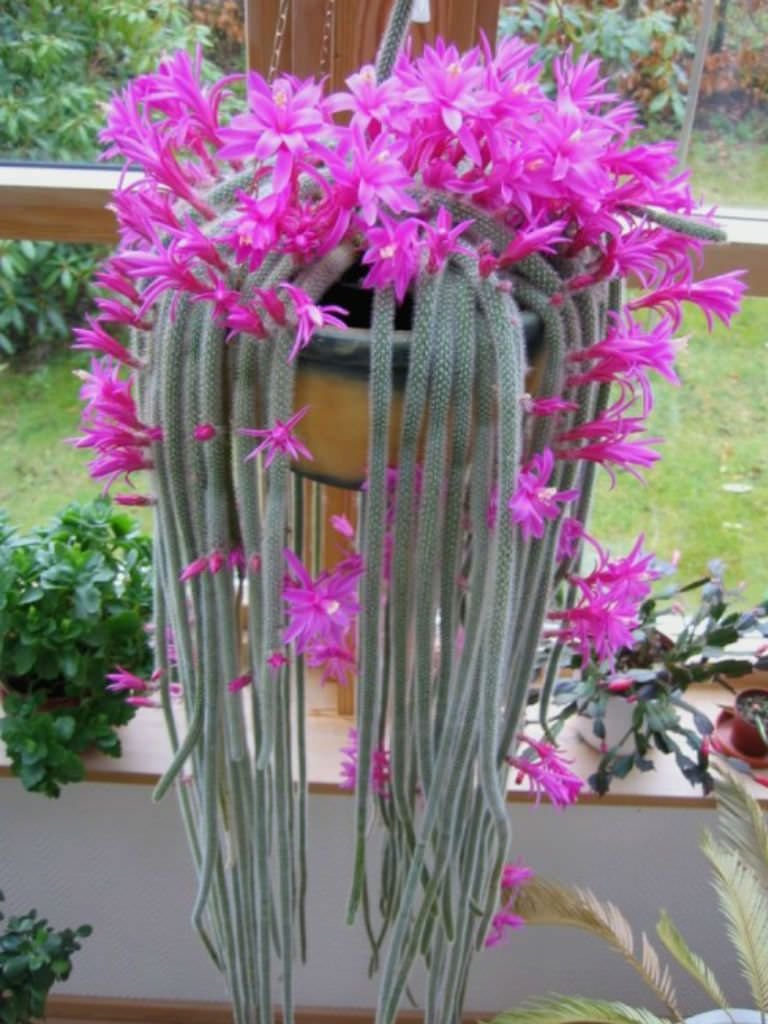
The Rat Tail Cactus Flower is generally violet-red but many a time blooming of a pink or orange-colored flower has also been witnessed.
The flowers are large and funnel-shaped and they grow from the Rat Tail Cactus Buds formed on the mature stems of the cactus.
When the flowers formed are orange in color, then the cactus is called Orange Rat Tail Cactus.
The appearance of flowers increases the aesthetic value of the cactus and makes the place look beautiful.
Photosynthesis in Rat Tail Catus
We know that generally, green leaves enable photosynthesis to occur.
But, in the case of the rat tail cactus, the photosynthesis style is a bit different and unique.
Let us discuss the rat tail cactus style of “photosynthesis”. The cactus lacks green leaves instead it has green stems.
Therefore, the trailing green stems do the work of photosynthesis. The vestigial stems and leaves form protective sharp thorns.
Thus, during the daytime, the Hanging Rat Tailed Cactus requires a good amount of sunlight so that the green stems can easily perform the process of photosynthesis.
Types of Trailing Cactuses
1. Golden Rat Tailed Cactus
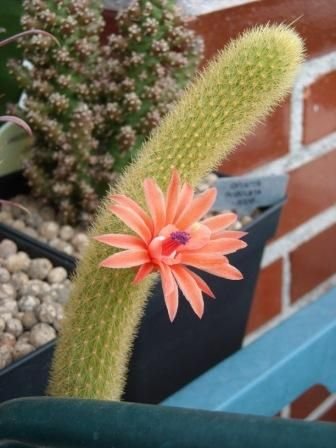
Cleistocactus winteri commonly known as the Golden Rat Tail Cactus. If you are looking for easy maintenance, fast-growing cacti plant, with a sparkling appearance, then your decision needs to be is the Golden Rat Tail Cacti are just what you need.
These cacti plants unique and wild appearance may not appeal to any gardener. But, if you are a succulent and cacti plant lover then, you should know that any cactus plant can make an exciting addition of beauty to your garden.
This type of Rat Tailed Cactus with the physical shape of cylindrical stems covered with short golden spines. These Cactuses are native to Bolivian deserts in South Africa and grow up to the height of about 3.5 feet with a stem width of about 0.2 feet.
The Cactus Plants blooms with large orange or salmon-pink flowers during the spring or summer seasons.
2. Monkey Tailed Cactus
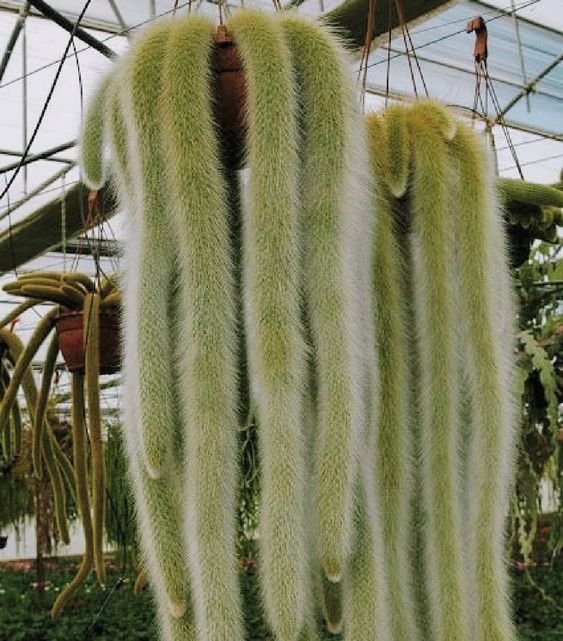
Hildewintera colademononis commonly known as the Monkey Tailed Cactus is another type of trailing cactus with long draping stems covered with prickly white spines. The cactus grows native to the deserts of Argentina in South America.
The Cactus grows up to a height of about 2 feet before the stems droop. The cactus blooms to form large reddish flowers with soft white hair-like spines.
Monkey Tailed Cactus vs Rat Tail Cactus, How to differentiate between the two?
Monkey Tailed Cactus looks like the tail of the monkey. Many a time, the stems of the Rat Tail Cactus may look like the Monkey Tailed Cactus.
But, the major difference between both is the length of the trailing stems. For the monkey tail cactus, the stem is about 2 feet long but for the Rat Tail Cactus the stem lengthens up to about 5 feet.
Moreover, the stem is slightly yellowish for the Monkey Tailed Cactus but the stem is green for the Rattail Cactus.
3. Peanut cactus

Echinopsis chamaecereus commonly known as the peanut cactus is a type of trailing cactus with finger-like stems of about 0.5 feet in length with a width of about half an inch covered in soft white spines. The cactus is native to the deserts of Argentina.
The Peanut Cactus is a low-growing plant with bright attractive orange or red flowers, making it a popular houseplant or addition to a cacti garden that usually blooms in the spring season.
4. String of Pearls
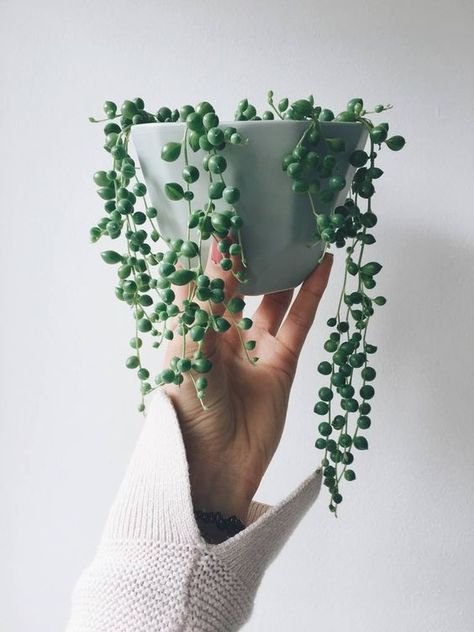
Senecio rowleyanus commonly known as the string of pearls is one of the most popular trailing cactus. The trailing stems are about 3 feet long and are covered with pea-shaped tiny leaves.
In summers, the string of flowers blooms to form small cinnamon-scented white flowers.
Awareness
Although these types of cacti plants are beautiful, these String Of Pearls plant is “Toxic To Dogs” as well as to “Human” Beings. In the case of humans, the eating part of the cacti plant can cause moderate gastrointestinal symptoms, such as nausea and vomiting.
5. Calico Kitten
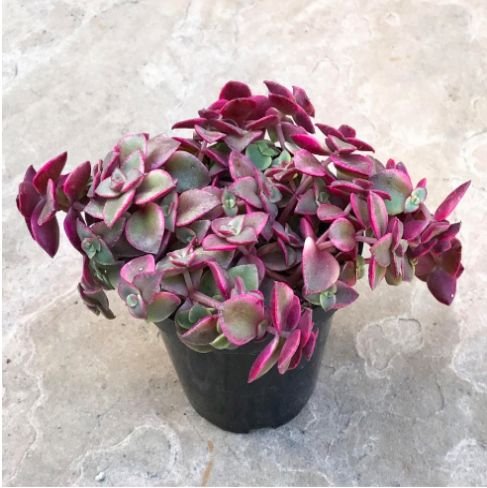
Crassula marginalis rubra commonly known as the calico kitten is a cute cactus with long trailing stems ornamented by heart-shaped leaves. The trailing stem is about 12 feet long. The cactus is native to the deserts of South Africa.
These are beautiful cacti plants possessing heart-shaped leaves which are in varieties of colors like; pink, creamy white, and pastel green, rosy pink.
The white flowers of Calico Kitten Plants bloom in spring and occasionally throughout the season. Calico Kitten plants are also easy to grow indoors and out. They look greatly admired in rock gardens, hanging baskets, and xeriscapes.
In spring, the calico kitten blooms to form petite white flowers.
Problems and solutions
Below are a few common succulent problems.
1. Wilting
Are you wondering why is my Rat Tail Cactus Wilting?
The cactus grows well in minimum humid conditions. Even the humidity present at normal room temperature is suited for its proper growth. But if the humidity increases then it might lead to its wilting.
So, what is the solution?
Make sure that the watering of the cactus is done properly. If the humidity of the place increases, then cut short the watering schedule of the cactus.
2. Root rot
Are you wondering why is my rat-tail cactus turning yellow?
If the stem of your rat tail cactus is turning yellow, then it is a sign of root rot which happens only because of overwatering.
So, how to solve the issue?
Stop watering the cactus as it starts turning yellow. Now, re-pot the plant into a soil mix having a good water draining system.
3. Thinner spines
Are you wondering why are my rat-tail cactus spines growing thin?
The spines and the stems of the rattail cactus grow thin when an adequate supply of sunlight is not provided.
To solve this issue,
The plant needs to be placed in a bright sunny area.
4. Spider mites
When the climate is extremely dry then at that time the cactus has risks to spider mites attack.
The spider mites suck the sap from the stem surface thereby drying up the cactus.
The spider mites are invisible to the naked eye but their white-colored nests are an indication of the spider mite attack.
How shall we deal with it?
If the spider mite infestation is heavy, then we need to treat the cactus with insecticides consisting of neem oil.
For not so serious attacks, washing the infected part under running water will do.
5. Scale insects
Scale insects are larger than spider mites and they are visible to the naked eye because of their dome shape.
These insects attack Rat Tail Cactus by attaching themselves to the stem surface.
How to remove them?
Scale insects can be removed by wiping them off the stem surface using cotton swabs dipped in dilute alcohol.
Toxicity toward pets and children
Aporocactus flagelliformis is quite non-toxic to pets and children. But remember that the cactus has stems covered with spines hence, pets and children should be kept at a safe distance from it.
Pricking the thorns may cause irritation and rashes.
10 safe cactus & succulents for pets and children.
Purchase
The Rattail Cactus is a showy low maintenance cactus and is a great purchase to be made by novice gardeners and people with busy schedules.
The cactus requires low watering and bright sunlight. It thrives well at room temperature. The cactus can also withstand quite low temperatures up to 40 degrees.
Just the thing is that the cactus needs to be trimmed when it gets too long.
Yearly re-potting of the cactus is needed as it grows fast and to accommodate the cactus large-sized hanging pots are required.
The cactus can be purchased from online boutiques and nearby nurseries. Moreover, at present, we have the rat tail cactus for sale in many online boutiques. Hence, it is a favorable time to make a houseplant purchase within budget.
Curtains down
Aporocactus flagelliformis is a great trailing cactus to be grown as a houseplant.
In this busy world, cacti purchases are increasing rapidly because of their low maintenance.
The aesthetic value of this cactus is also impressive and hence can also be used as decorative item.
Although the cactus is of low maintenance, still we need to be quite particular with the watering schedule. Moreover, we also need to make sure that the cactus is receiving an adequate amount of sunlight.
Trimming of the rat tail cactus must be done when the trailing stems grow too long. Yearly re-potting of the cactus is recommended.
The hanging pots must be quite large-sized to accommodate the growing roots. Moreover, whenever re-potting the cactus, the cactus soil mix should be freshly bought or freshly prepared.
Once the cactus blooms, the beauty of the flowers increases the look of the place. The aesthetic value of the cactus also increases.
Mostly, such cacti are purchased because of their unique structures and looks.
Thus lastly, the cactus is a valuable purchase to be made.
I hope that you had a fun, informative, and helpful reading about the rattail cactus.
Happy planting now!
Top 10 Hanging Succulents and Cacti worth Having at Homes and Offices
